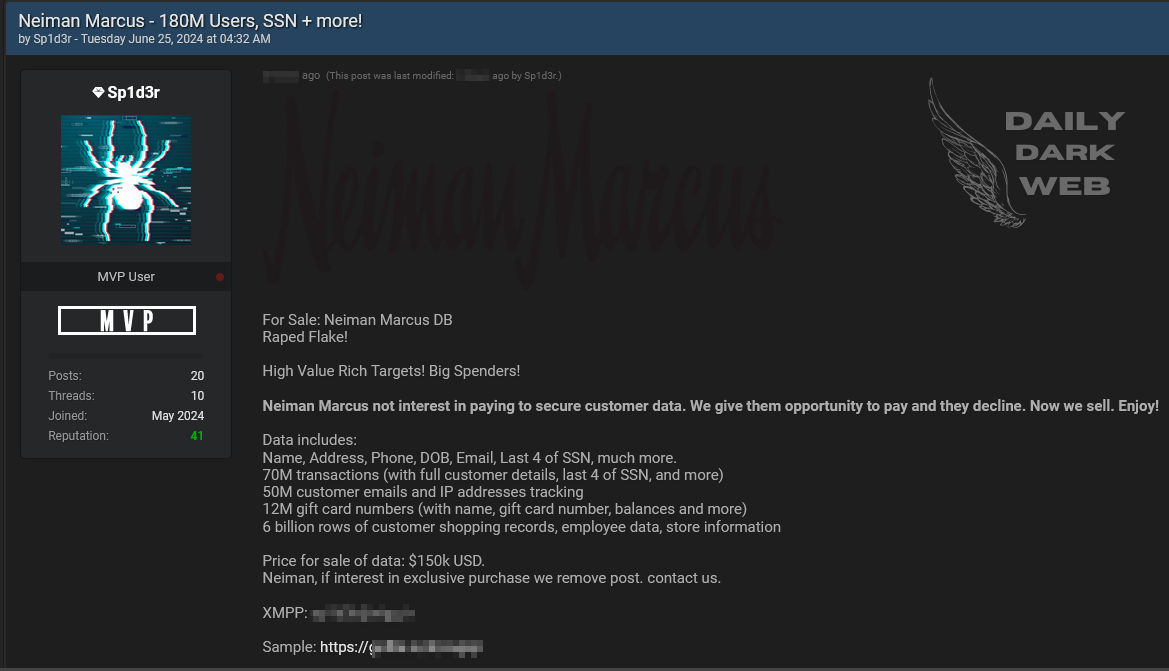[ad_1]
Luxury retail chain Neiman Marcus has begun to inform customers about a cyberattack it discovered in May. The attacker compromised a database platform storing customers’ personal information.
The letter tells customers:
“Promptly after learning of the issue, we took steps to contain it, including by disabling access to the relevant database platform.”
In the data breach notification, Neiman Marcus says 64,472 people are affected.
An investigation showed that the data contained information such as name, contact data, date of birth, and Neiman Marcus or Bergdorf Goodman gift card numbers. According to Neiman Marcus, the exposed data does not include gift card PINs. Shortly after the data breach disclosure, a cybercriminal going by the name “Sp1d3r” posted on BreachForums that they were willing to sell the data.

“Neiman Marcus not interested in paying to secure data. We give them opportunity to pay and they decline. Now we sell. Enjoy!”
According to Sp1d3r, the data includes name, address, phone, dates of birth, email, last four digits of Social Security Numbers, and much more in 6 billion rows of customer shopping records, employee data, and store information.
Neiman Marcus is reportedly one of the many victims of the Snowflake incident, in which the third-party platform used by many big brands was targeted by cybercriminals. The name Sp1d3r has been associated with the selling of information belonging to other Snowflake customers.
Oddly enough, Sp1d3r’s post seems to have since disappeared.

Sp1d3r’s post count went down back to 19 instead of the 20 displayed in the screenshot above.
So, the post has either been removed, withdrawn, or hidden for reasons which are currently unknown. As usual, we will keep an eye on how this develops.
Protecting yourself after a data breach
There are some actions you can take if you are, or suspect you may have been, the victim of a data breach.
- Check the vendor’s advice. Every breach is different, so check with the vendor to find out what’s happened, and follow any specific advice they offer.
- Change your password. You can make a stolen password useless to thieves by changing it. Choose a strong password that you don’t use for anything else. Better yet, let a password manager choose one for you.
- Enable two-factor authentication (2FA). If you can, use a FIDO2-compliant hardware key, laptop or phone as your second factor. Some forms of two-factor authentication (2FA) can be phished just as easily as a password. 2FA that relies on a FIDO2 device can’t be phished.
- Watch out for fake vendors. The thieves may contact you posing as the vendor. Check the vendor website to see if they are contacting victims, and verify the identity of anyone who contacts you using a different communication channel.
- Take your time. Phishing attacks often impersonate people or brands you know, and use themes that require urgent attention, such as missed deliveries, account suspensions, and security alerts.
- Consider not storing your card details. It’s definitely more convenient to get sites to remember your card details for you, but we highly recommend not storing that information on websites.
- Set up identity monitoring. Identity monitoring alerts you if your personal information is found being traded illegally online, and helps you recover after.
Check your exposure
While matters are still unclear on how much information was involved in the Neiman Marcus breach, it’s likely you’ve had other personal information exposed online in previous data breaches. You can check what personal information of yours has been exposed with our Digital Footprint portal. Just enter your email address (it’s best to submit the one you most frequently use) to our free Digital Footprint scan and we’ll give you a report.
We don’t just report on threats – we help safeguard your entire digital identity
Cybersecurity risks should never spread beyond a headline. Protect your—and your family’s—personal information by using identity protection.
[ad_2]
Source link
